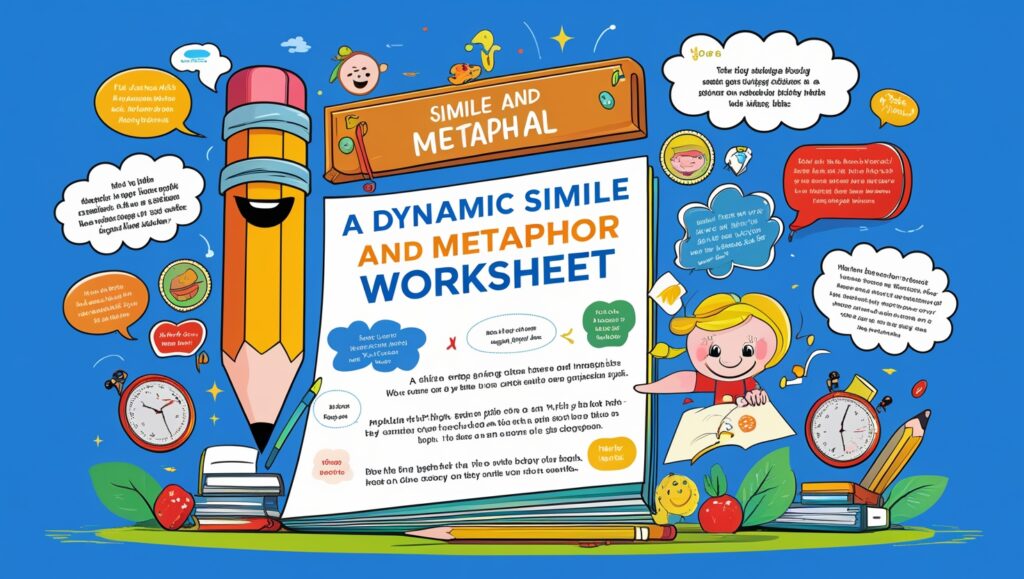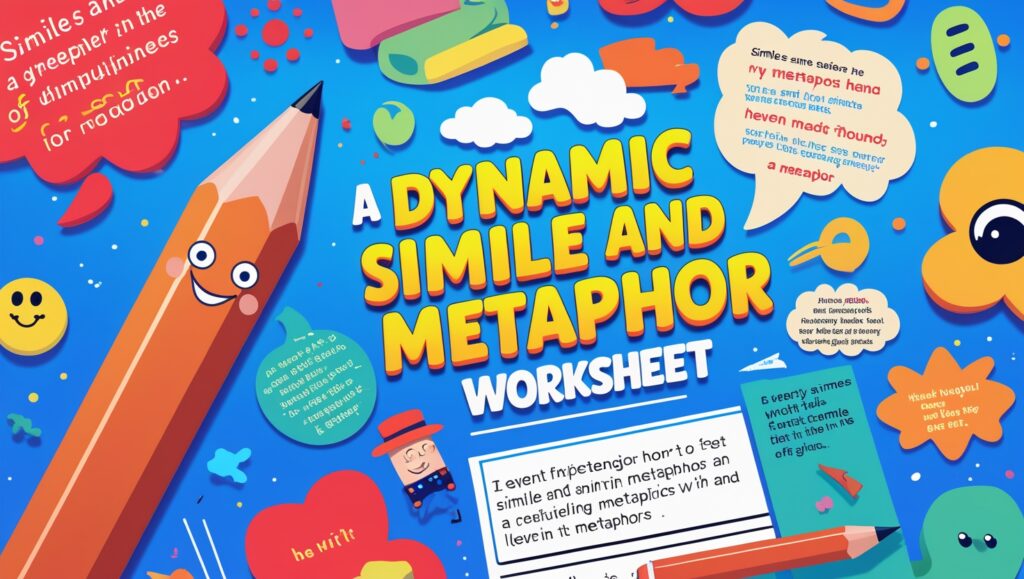Language is a long way more than just a device for verbal exchange—it’s far a powerful approach to explicit creativity, feelings, and memories. Central to expressive writing are similes and metaphors, vital literary devices that help us paint shiny snap shots and bring mind to resourceful and impactful procedures. By drawing comparisons, the figures of speech improve our language, making messages clearer and extra engaging.
For each freshmen and seasoned writer, information similes and metaphors elevate fundamental writing into something fascinating and memorable. When applied thoughtfully, those equipment can flip an ordinary sentence right into a compelling story or a persuasive argument that resonates with readers.
Well-crafted simile and metaphor worksheets pass beyond repetitive exercise; they encourage critical thinking and foster the capability to precise ideas with originality and ability. These instructional belongings are useful for teachers and newbies alike, making the manner of reading language now not high-quality instructive however also exciting.
In this article, we are capable of discovering what similes and metaphors are, highlight the important differences among them, and provide a cause of why they’re crucial for powerful conversation. Additionally, we’ll discuss how targeted workout thru worksheets can assist rookies with any luck to make their progressive writing skills bigger.
What Is a Simile?
A simile is a form of figurative language that compares two various things by using the terms “like” or “as.” This tool makes descriptions more vivid, relatable, and much less hard to apprehend with the resource of linking unusual thoughts to familiar photographs.
Key Features of Similes:
- Use “like” or “as” to attract comparisons
- Simplify complicated ideas with the aid of way of pertaining to them to everyday gadgets or opinions
- Enhance emotional and sensory impact in writing
- Commonly determined in poetry, memories, and normal communique
Examples of Similes:
- “The sun was the reason her smile was so radiant.”
- “He moved much like the wind.”
- “The toddler’s skin and pores are as smooth as silk now.”
- “She’s as courageous as a lion.”
Similes are mainly beneficial for beginners due to the truth they make writing extra expressive and much less complicated to visualise at the same time as being honest to apply.
See also “Unpacking ‘As Mean as a…’ Similes“
What Is a Metaphor?
Unlike similes, metaphors make an instantaneous comparison without using “like” or “as.” They state that one issue is a few differences, which frequently provides deeper meaning and symbolism to the text, developing robust mental pictures and emotional resonance.
Key Features of Metaphors:
- Make direct comparisons without “like” or “as”
- Convey symbolic or revolutionary meanings
- Create powerful, lasting impressions inside the reader’s mind
- Widely applied in literature, speeches, and progressive writing
Examples of Metaphors:
- “Time is a thief.”
- “His heart has turned into a block of ice.”
- “She is a celebrity within the examination room.”
- “The global is a degree.”
Metaphors are especially powerful in storytelling and persuasive writing because of the reality they convey complex minds succinctly and impactfully.
Why Use Simile and Metaphor Worksheets?
Reading about figurative language is useful, but actively practicing these ideas is what virtually builds skill. Simile and metaphor worksheets are practical equipment that inspire hands-on getting to know and beef up information through software.
Benefits of Using Worksheets:
1. Engaged Learning: Worksheets activate newcomers to create their personal comparisons, turning abstract ideas into concrete understanding.
2. Fostering Creativity: Thoughtfully designed sports invite students to test with language and expand their precise voice in a supportive putting.
3. Improving Descriptive Skills: Regular exercise with figurative language helps college students write more obviously and optimistically.
4. Enhancing Critical Thinking: Advanced activities project beginners to analyze meanings, distinguish among similes and metaphors, and refine examples.
What Makes an Effective Simile and Metaphor Worksheet?
An impactful worksheet is greater than a listing of responsibilities—it gives a structured gaining knowledge of adventure. Here are key factors to include:
- Clear Definitions with Examples: Start with simple reasons and relatable examples, specifically for more youthful or novice freshmen.
- Identification Exercises: Provide sentences for college students to label as similes or metaphors.
Example: “The school room turned into a zoo.” — Metaphor
- Fill-in-the-Blank Prompts: Encourage university students to finish comparisons creatively.
Example: “The night became as silent as ___.”
- Match Expressions to Meanings: Reinforce statistics through linking figurative phrases to their meant interpretations.
Example: “He’s a night owl.” → Someone who remains up late.
- Creative Writing Tasks: Inspire unique questioning with the useful resource of getting novices create their very very own similes or metaphors based mostly on prompts.
Prompt: Use a metaphor to describe a thunderstorm.
Sample Response: “The thunderstorm became a drumline beating thru the sky.”
- Multiple-Choice Questions: Use quick quizzes to test comprehension.

Effective Teaching Strategies for Figurative Language
Successful exercise involves creativity and engagement. Here are hints to enhance the studying revel in:
- Use Visual Aids: Have college students describe pix with similes or metaphors to attach visuals with language.
- Turn Learning proper into a Game: Incorporate interactive video games like “Simile Showdown” or “Metaphor Match-Up” to hold exercising fun.
- Encourage Daily Writing: Suggest that novices write one simile and one metaphor each day to construct fluency and innovative addiction.
- Leverage Technology: Use digital gadgets collectively with interactive quizzes, apps, or online school rooms to feature range and accessibility.
Common Mistakes and How to Fix Them
Figurative language can be complex at the beginning. Here are traditional errors and techniques to cope with them:
- Confusion between Metaphors and Similes: Emphasize that while metaphors no longer utilize “like” or “as,” similes do. Aspect examples can help make things apparent.
- Making Literal Comparisons: Encourage ingenious, colourful language in preference to undeniable descriptions. Instead of “The apple is crimson like a tomato,” try “The apple turned into as purple as a glowing sunset.”
- Relying on Clichés: Motivate beginners to keep away from overused terms and create fresh, authentic imagery that reflects their non-public mindset.
Choosing Between Print and Digital Worksheets
Both printable and digital formats have precise blessings and may be used in line with coaching needs:
Printable Worksheets:
- Great for arms-on sports and in-man or woman classes
- Useful for homework and organizational purposes
- Easily customized for diverse age organizations and talent stages
Digital Worksheets:
- Ideal for faraway or hybrid gaining knowledge of environments
- Interactive features like drag-and-drop and instantaneous remarks
- Convenient for college students who select typing or require accessibility alternatives
Choosing the right layout relies upon your teaching context and gaining knowledge of desires, however both can efficiently support mastery of figurative language.
Deeper Understanding of Similes and Metaphors
🔹 Advanced View of Similes
A simile doesn’t just make writing colorful—it helps bridge a reader’s imagination with the writer’s reason. Skilled authors use similes no longer best for imagery but also to shape tone, evoke emotions, and guide interpretation.
Example:
- “The argument turned into something as fragile as glass.” → This doesn’t just inform you it’s fragile; it also suggests anxiety and the possibility of shattering relationships.
Pro Tip for Writers: Strong similes frequently use sensory comparisons (sight, sound, touch, flavor, smell) to make a reader experience the outline, not just recognize it.
🔹 Advanced View of Metaphors
Metaphors are extra than direct comparisons—they bring about symbolic weight. A proper metaphor transforms summary principles into something tangible.
Example:
- “Hope is the anchor of my soul.” → The metaphor conveys balance, protection, and grounding without ever describing the ones features literally.
Pro Tip for Writers: Effective metaphors are frequently layered, carrying each a direct picture and a deeper thematic meaning.
Expanded Examples for Worksheets
Similes:
- “The lights in the city glistened like fireflies.”
- “His voice was as hot as a summer night’s night.”
- “The cake was as mild as a cloud.”
Metaphors:
- “Her laughter became tuned to his ears.”
- “The study room became a beehive of pastime.”
- “A shadow that follows close behind is fear.”
How to Design Highly Effective Worksheets
If you need worksheets that stand out, they ought to:
1. Build from Basic to Complex – Start with reputation tasks, then move to introduction and analysis.
2. Include Real-World Context – Use examples from pop culture, books, or pupil reviews to make getting to know applicable.
3. Incorporate Cross-Curricular Links – Tie simile/metaphor practice into technological know-how, history, or art training.
4. Offer Peer Review Opportunities – Have college students proportion and critique each other’s figurative language to encourage constructive feedback.

Extra Creative Worksheet Activities
Here are some clean, lecture room-tested thoughts you could add:
- Metaphor Makeover: Give students a cliché metaphor and have them rewrite it with an original twist.
- Simile Scavenger Hunt: Assign college students to find similes in a unique, song lyrics, or movie communicate.
- Sensory Expansion: Give a simple sentence (“The lawn changed into beautiful.”) and ask them to rewrite it using all 5 senses with similes/metaphors.
- Two-in-One Challenge: Require college students to mix a simile and metaphor in an unmarried short paragraph.
- Reverse Engineering: Give college students a metaphor (“The moon is a silver coin in the sky.”) and ask them to explain what it means without the usage of figurative language.
MCQs
1. Which of the following is a defining feature of a simile?
A) Directly comparing without using the terms “like” or “as”
B) Comparing two unlike things using “like” or “as”
C) Using rhyme and rhythm in writing
D) Describing something in literal terms
Correct Answer: B
2. Which of these sentences is a metaphor?
A) “Her eyes were as bright as diamonds.”
B) “The world is a stage.”
C) “He runs like the wind.”
D) “The infant had silk-soft skin.”
Correct Answer: B
3. Which is NOT a benefit of using simile and metaphor worksheets?
A) Enhancing critical thinking
B) Building creativity in writing
C) Improving descriptive skills
D) Eliminating all figurative language from writing
Correct Answer: D
4. Which example best demonstrates sensory imagery in a simile?
A) “The thunderstorm was a drumline beating through the sky.”
B) “As light as a cloud, the cake was.”
C) “Time is a thief.”
D) “Her laughter was music to his ears.”
Correct Answer: B
5. Which activity involves finding similes in books, music, or movies?
A) Metaphor Makeover
B) Reverse Engineering
C) Simile Scavenger Hunt
D) Two-in-One Challenge
Correct Answer: C
6. What is the main difference between a simile and a metaphor?
A) Similes compare literally, metaphors compare figuratively
B) Similes use “like” or “as,” metaphors do not
C) Metaphors are only used in poetry, similes are used in prose
D) Similes are always longer than metaphors
Correct Answer: B
7. In the metaphor “Hope is the anchor of my soul,” what does “anchor” symbolize?
A) Weight and heaviness
B) Stability and security
C) Travel and adventure
D) Sinking and failure
Correct Answer: B
8. Which feature is recommended for an effective figurative language worksheet?
A) Complex grammar rules only
B) Clear definitions and relatable examples
C) Lists of unrelated vocabulary words
D) Only fill-in-the-blank exercises
Correct Answer: B
9. Which of the following is a common mistake when learning figurative language?
A) Mixing metaphors and similes
B) Using sensory details
C) Practicing daily writing
D) Avoiding clichés
Correct Answer: A
10. What is the purpose of the “Metaphor Makeover” activity?
A) To create completely new figurative language examples from scratch
B) To rewrite a cliché metaphor with a fresh, original image
C) To identify metaphors in famous literature
D) To turn metaphors into similes
Correct Answer: B
11. Which example is a simile that compares movement?
A) “Fear is a shadow that follows close behind.”
B) “He moved like the wind.”
C) “She had a smile that was as radiant as the sun.”
D) “The classroom was a beehive of activity.”
Correct Answer: B
12. Which teaching strategy uses imagery to inspire figurative language?
A) Peer Review Exercises
B) Using Visual Aids
C) Sensory Expansion
D) Reverse Engineering
Correct Answer: B
13. According to the metaphor in “The classroom was a zoo,” the space was:
A) Full of animals
B) Quiet and peaceful
C) Chaotic and noisy
D) Small and crowded
Correct Answer: C
14. Why are digital worksheets useful for figurative language practice?
A) They require no creativity
B) They allow drag-and-drop activities and instant feedback
C) They can only be used in physical classrooms
D) They do not require internet access
Correct Answer: B
15. Which example best shows a metaphor about fear?
A) “Fear is a shadow that follows close behind.”
B) “He was as scared as a little mouse.”
C) “Her hands shook like leaves in the wind.”
D) “The room was as silent as midnight.”
Correct Answer: A
Summary
This article explains what similes and metaphors are, how they range, and why they’re critical for creative and effective writing.
It defines similes as comparisons using “like” or “as” and metaphors as direct comparisons without those phrases, imparting examples of every. The piece emphasizes that worksheets assist newbies actively practice figurative language, enhancing creativity, descriptive capabilities, and vital questioning.
It outlines what makes a good worksheet—clean definitions, identification exercises, creative prompts, matching sports, and brief quizzes—and suggests teaching techniques like visible aids, video games, and daily writing. Common mistakes (e.G., puzzling similes and metaphors, the use of clichés) are addressed with guidelines to repair them.
The article additionally compares print and digital worksheets, discusses superior uses of similes and metaphors for tone and symbolism, and gives classroom-tested activities like “Metaphor Makeover” and “Simile Scavenger Hunt.” It closes with more than one-preference questions to reinforce gaining knowledge of.
Read more about Similes At Idiomsinsider

